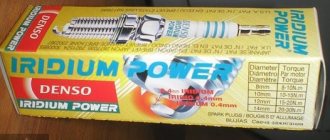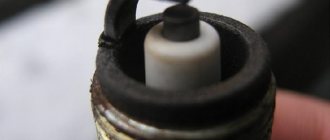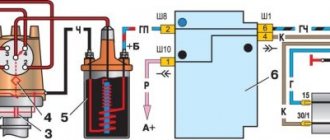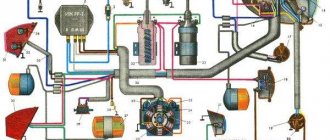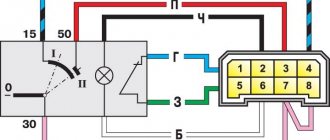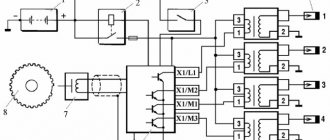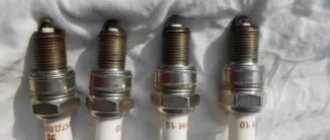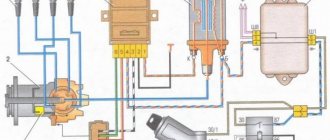Why is a gap between electrodes necessary?
The key to stable engine operation is the good condition of the spark plugs, that is, the absence of carbon deposits on the electrodes and the correct gap between them. Now we have come close to this term.
The gap is the distance between the central and side or side (if there are several) electrodes of the spark plug.
The central one is the positive electrode; it is supplied with high voltage current from the ignition coil.
The side electrode is, respectively, negative. A spark or arc discharge passes between two electrodes, and it occurs at the moment an electrical impulse is supplied from the ignition coil. Its characteristics will primarily depend on the gap on the spark plug. It is the spark that ignites the working mixture in the cylinder. There will be no spark - there will be no fuel combustion, and, accordingly, no useful engine operation, either. What clearance is required for your car's engine can be found in the owner's manual. Or go the other way, in a car store, if you take a box of spark plugs, there will definitely be a list of makes and models of cars indicating the engines on which it can be installed.
I myself have repeatedly seen that car enthusiasts simply come to the store and ask the seller to select spark plugs for a certain car, that is, they don’t bother, but leave the selection to the seller. And if he makes a mistake... At the car service center, they won’t bother either, they will supply you with what you brought. As a result, we get that new spark plugs are installed on the car, and the engine runs even worse than with the old set. Therefore, I recommend choosing the spark plugs yourself, at least according to such a parameter as the gap, especially where I wrote in the paragraph above where to find it.
There are ranges of clearance values for engines with different types of power supply and ignition systems, for example:
- carburetor engines (VAZ, GAZ, etc.) with a breaker-distributor in the ignition system (if according to the collective farm, then a distributor): 0.5–0.6 mm.
- carburetor engines with electronic ignition: 0.7–0.8 mm.
- injection engines: 1.0–1.3 mm.
Modern technologies
What I want to say in conclusion, many will think “come on,” why should I bother with some distance between the electrodes! Guys, very wrong thoughts.
Firstly, you can save on fuel, studies show up to 5 – 7%
Secondly, smooth engine operation is the key to driving safety.
Third, the correct gap between the spark plugs increases their service life; there is no chance that the insulator will break through (with an increased distance).
I would like to note that some companies, on the contrary, increase the number of contacts (electrodes), strengthen the coils and the ignition system, all so that the mixture is ignited better.
There are also more modern technologies now, which I think will soon replace them - such as plasma candles.
They have no electrodes at all, and the fuel is ignited by a beam of plasma that is generated by electricity. As they write, the production is now undergoing tests and they say that the combustion efficiency of the fuel mixture is increasing, which means a little more power, a little more economy and environmental friendliness of the engine.
What causes an incorrect spark plug gap?
The distance between the electrodes can deviate from the norm both up and down. Depending on which gap, increased or decreased, the consequences will be different.
Types of motors affected by incorrectly set gap
The most critical consequences of insufficient or excessively large distances between the electrodes of the spark plugs appear on carburetor engines. In contrast to electronic ignition systems, which are capable of reacting to some extent to the operation of spark plugs and compensating for problems that arise by changing the quality of the working mixture. The carburetor practically does not have such capabilities.
In addition, the electrical circuits of the simplest engines with a carburetor are designed for lower voltage than, for example, systems with an injector. Therefore, on carburetors, any deviations in the spark plug gap from the norm appear more clearly.
Increased clearance
This deviation is dangerous, first of all, because it can cause breakdown of the spark plug insulator or ignition coil. This happens because electricity strives to find the shortest path for itself.
If breakdown does not occur, there is a high probability of spark loss. In this case, the cylinder simply will not work and the engine will start to stall. A characteristic sign of an increased gap between the electrodes is popping noises in the exhaust system. At high speeds, misfires become especially noticeable.
Please note that over time, the electrodes burn, and the gap between them increases naturally. For this reason, it is advisable to check single-electrode spark plugs every 10-15 thousand kilometers. Multi-electrode spark plugs need to be checked much less frequently.
Reduced clearance
If the interelectrode gap is less than normal, the spark discharge that ignites the combustible mixture is very powerful and short. The latter leads to the fact that the fuel in the cylinders does not have time to ignite, and the spark plugs will begin to flood, and the engine will begin to stall.
At high speeds there is a high probability of arcing. Due to the fact that the distance between the electrodes is too small and the crankshaft speed is high, the spark does not have time to break, and a continuous stream of plasma is formed. As a result, the ignition coil may short out or, at a minimum, malfunctions in the operation of the power unit may occur.
Interelectrode gap for different spark plugs
Cars that use gas as fuel involve a different method of fuel combustion. Thus, propane has a high octane number and high combustion temperatures. As a result, the use of spark plugs with the lowest heat value is required when refueling with 92-grade gasoline.
In a situation where the car is designed for 95 gasoline, then when installing gas equipment, you can use spark plugs with the recommended gap. Thus, it will not be possible to simply bend the side contact onto the spark plugs for a gas-powered unit.
Owners of foreign cars are often interested in the question: what gap between the spark plug and the “precious” electrode is considered normal? Spark plugs with a central contact made using iridium, platinum or silver are considered to be of higher quality. The contact gap in these parts is large. And the use of such “precious” metals affects the resistance of the material to high temperatures. This is based on the fact that the resulting spark charge is more stable and does not depend on the gap between the electrodes.
The reluctance to measure the spark plug gap is due to the slowdown in replacing old elements. But if you carry out this procedure in a store or directly at the car, you can avoid many problems during engine operation. After all, contacts can be damaged during transportation and loading, which in the future will affect the appearance of defects in the operation of the car.
The presence of interference when the fuel mixture ignites is often associated with improper operation of the spark plug, namely the inaccurate distance between the electrodes.
Spark plugs are the most important component in the operation of a gasoline engine. After all, they are responsible for the moment of ignition of the air-fuel mixture. The gap on the spark plugs and injector must be selected in the finest possible way, however, carburetor engines are no exception.
Perhaps the most important parameter in any automotive spark plug is the gap between the electrodes. It is selected depending on how much current is supplied in the ignition system. If, for example, a weak current is applied to a spark plug with an incomparably large gap, then it will be weak. This is often visible visually when the spark is not blue, but reddish, and its temperature is too low to ignite the air-fuel mixture.
There is nothing good about a small gap either. If the current is too high and the gap is too small, the spark plug electrodes will wear out quickly. If you look deeper, a spark is essentially an impact of electrons on an electrode, resulting in the release of heat. So, with a small gap the impacts will be much stronger.
In this regard, it is necessary to very carefully adjust the gaps of the spark plug electrodes to the specified current.
Gap on injector spark plugs
In injection engines, high voltage is achieved thanks to the electronic spark supply system. In this regard, on injector engines, the spark plug electrode gap should not be less than 1 mm. This distance is enough for the spark plug to be provided with a powerful spark to ignite the fuel.
If the gap is less than 1 mm, then this will probably not affect the operation of the engine, but will lead to accelerated wear of the electrodes. However, any electrodes wear out over time, so the gap needs to be adjusted from time to time.
If we compare the gap on the injector spark plugs with a conventional carburetor engine, then the gap here is set to about 0.6-0.7 mm. All this is because a conventional breaker takes a significant amount of energy and a low-power spark is supplied to the spark plugs.
Of course, if a carburetor engine uses an electronic ignition system, MPSZ, for example, then the spark plug gap here should be set to the same as on the injector.
What is the norm
The normal value ranges from 0.4 to 1.3 mm. What should be the gap on the spark plugs depends on the type of system:
- In carburetor engines, where the function of the ignition distributor is performed by a distributor, that is, on a “classic” engine, the gap between the contacts should be from 0.5 to 0.6 mm.
- If the engine is carburetor, but the ignition is electronic, then set the gap to 0.7-0.8 mm.
- For injection engines, the optimal distance is in the range from 0.9 to 1.2 mm.
Taking these recommendations into account, you can ensure the most stable operation of the motor.
Normal clearance size
The permissible limits of the interelectrode distance are from 0.6 to 1.2 mm. A more precise value is selected depending on the type of engine, power supply and ignition system:
Advice. The best way to correctly determine the interelectrode clearance for a particular vehicle is to carefully study the operating instructions. In the vast majority of cases, this value is indicated among other setting parameters.
Since the owners of many vehicles equipped with gasoline engines switch to liquefied gas, the size of the spark plug gap requires adjustment. For high-quality combustion of a mixture of propane and air, it is recommended to increase the ignition intensity by increasing the clearance by 0.1 mm from the rated value. The load on the high-voltage coil will increase slightly, and the gas will burn better.
For example, the spark plug electrodes of a carburetor engine with electronic ignition must be bent to 0.9 mm, if the operating instructions indicate the figure 0.8. Do not listen to bad advice and do not make the gap too large, because automobile gas installations of all generations start on gasoline, and then automatically switch to supplying a propane-butane mixture from a cylinder. In addition, you will still have to use gasoline fuel to get to the gas station when the gas in the tank runs out.
When does spark plug gap need to be adjusted?
The gap on the spark plug is set at the manufacturing plant, and it should not worry the driver if the engine is running stable. But all cars can have problems in the combustion chamber, and many of them can be diagnosed by spark plug soot. Accordingly, in the event of certain malfunctions, the spark plug gap may change and will need to be set as recommended. Even with stable engine operation, the gap on low-quality spark plugs may change slightly, which is why it is not recommended to skimp on them. A slightly changed gap will affect fuel consumption, and the saying “the miser pays twice” will come into play.
Experienced car owners recommend checking the gap in the spark plugs and comparing it with the standards 2 times a year. This is due to the fact that every six months, caring drivers clean the spark plug from carbon deposits, and it is convenient to also adjust the gap during this procedure.
Designation of NGK spark plugs: marking
As mentioned above, decoding NGK candles helps to avoid errors and inaccuracies in the selection process. It is well known that the manufacturer sells products in branded packaging. As for markings, special codes can be found on the body of each spark plug.
Such designations on NGK spark plugs greatly simplify the entire selection process. Knowledge of the labeling allows you to accurately determine which option from the NGK product range will be the most suitable in terms of the main parameters. Marking codes are displayed in the NGK catalog, after which selection is carried out using printed tables, online services, etc. So, it is best to consider the issue of marking spark plugs using ready-made examples.
From this variety, you need to choose a gasoline engine or a motor that runs on gas. Then you will need to enter the make and model of the car, after which a table will be displayed indicating all modifications and technical characteristics of the internal combustion engine. Based on the table, further accurate selection of candles is carried out.
How to measure the gap between electrodes
The gap between the electrodes changes during operation, since the spark plug is constantly exposed to electrical voltage and high pressure. It is recommended to check the distance between the electrodes every 15 thousand km. (or 30 thousand km for multi-electrode devices) and correct it.
To measure, you will need a special tool - a probe. Three types of tools are used:
- Coin-shaped - along the edge of the “coin” there is a thickening rim, which is the meter. Insert the rim between the electrodes and turn the “coin” so that the rim stands between them. Then look at the designation that is printed on the disk. It indicates the width of the rim at a specific point. The disadvantages of such a probe are that it can become worn down and can accidentally increase the gap between the contacts.
- The coin-wire device is also a round tool, but the gap is measured by inserting wires attached to the body between the electrodes. They have a fixed thickness, so it is not possible to accurately determine the distance.
- Flat probe - the tool is a set of probes that differ in thickness. It looks like a Swiss Army knife. To make a measurement, select a probe of the required thickness (several probes can be used). There are tools of a combined type with wires, that is, combining this and the previous options.
To measure the gap, the spark plugs are removed from the engine. To do this, you will need a 16 or 21 head. First, disconnect the armor wires, and then unscrew the spark plugs. The removed devices are cleaned to remove carbon deposits and obtain a reliable measurement result.
Important! A large amount of carbon deposits indicates that the spark plugs will soon need to be replaced. If the carbon deposits are not completely cleared, then putting them back is not recommended.
You can use a small piece of clean cloth for cleaning. If you cannot remove the deposits with a cloth, you should apply medical alcohol to the surfaces of the electrodes.
After cleaning, measure the gap with a tool by placing the probe between the electrodes. Select a probe that corresponds in thickness to the value that needs to be set. If the probe does not fit between the contact surfaces, then the gap needs to be increased. If the probe fits freely between the electrodes, you need to bend the contacts in the direction of decreasing the distance. The probe should fit tightly between the contacts.
How to set the spark plug gap
Let us immediately note that new spark plugs may have either an increased or decreased gap. As for the spark plugs that were already on the car, during operation it is only possible to increase the gap (the surface of the electrodes burns out), and not to decrease it. At the same time, it is important that such spark plugs themselves are not damaged, that the electrodes, as well as the insulator, are intact, etc.
Having taken new spark plugs or cleaned the old ones, the gap needs to be measured. Some people do this with a simple ruler, but you need to keep in mind that the error is at least 0.5 mm. For this reason, test probes, which are much more accurate, should be used.
By inserting a suitable probe from the set between the electrodes, you can determine the size of the gap. As an example, consider adjusting the spark plugs for the injector. If the gap is larger or smaller than the required mark, then it is recommended to first set the largest optimal gap of 1.3 mm. Alignment is performed by bending the electrode. Next, carefully bending the side electrode with a special tool, the gap is reduced to 1.1 mm. After adjustment, the gap on the spark plugs is checked again using a feeler gauge.
HOW TO RECOGNIZE A FAKE
The downside of popularity is the huge amount of counterfeit products on the market. To be convinced of this, you don’t even have to go to a car store: on Ebay or Aliexpress, type “spark plug” in the search, and it will immediately give you a huge number of candles in familiar packaging and, of course, from China. Such volumes of counterfeit goods have already seriously damaged the company’s reputation - in many car repair shops to this day, in case of any problems with ignition, the first answer is “You first install normal spark plugs, not NGK ones.”
So, how can you spot a fake on a display? Let's start with the packaging. The slightest “jambs” in printing clearly indicate a cheap counterfeit; the boxes of original candles are always perfect.
The workmanship itself speaks for itself.
The contact tip of the original NGK seems to be made in one piece with the spark plug: it is impossible to unscrew it with your fingers. Markings on the insulator and metal skirt must be clear and even. The threads on original products are rolled, so they are always smooth and even. The roughness of the carving and the marks of the chisel indicate a dubious origin. Crooked electrodes, especially deviation of the side electrode from the central axis, is also a reason to refuse the purchase.
With counterfeit V-Line spark plugs, the direction of the groove in the central electrode is almost always disrupted - if at the factory, when soldering the side electrode, it is centered exactly along the groove, then with “basement” plugs their mutual orientation can be absolutely any. For candles with electrodes made of noble metals, since they are much more labor-intensive to manufacture, the differences from “singed” ones are even more striking, since it is unprofitable to fully maintain complex technology in the conditions of “left-handed” production.
Setup recommendations
Checking and adjusting the gap on the spark plugs of the ignition system is carried out in the following situations:
- After repairing the engine, power supply and ignition systems, or before measuring compression in the cylinders. During operation, the spark plug electrodes gradually burn out and become thinner, causing the gap between them to increase.
- When replacing spark plugs with new ones. Often the manufacturer sets the gaps too small, which have to be increased to normal.
- When the engine became unstable. The first step is to unscrew the spark plugs, thoroughly clean the contacts, adjust the interelectrode distances and check their performance under pressure.
Cleaning the electrodes and pads from carbon deposits should always precede adjustment.
An important point to remember is that it is impossible to clearly set the gap on the spark plugs without a feeler gauge. Adjusting by eye will do as a temporary measure until you get to the garage with the tool.
- Remove the spark plugs from the engine cylinders and allow them to cool to room temperature. It is impossible to measure the size of the gaps “hot”.
- Clean the contacts with a wire brush and check the gap between the electrodes with a probe of the required thickness. The latter should fit tightly between the contacts, with little resistance.
- If the feeler gauge does not fit, increase the gap by bending the top electrode with a flat-head screwdriver. Too large a distance can be removed by gently tapping the contact.
It is easier to perform the operation on a cooled engine - you won’t have to burn your hands while unscrewing. For regular spark plugs, use a flat probe, and for products with 2-3-4 side electrodes, use a round tool. Install the spark plugs in the cylinders, start the engine and observe the idle speed. If the previously noticed vibration does not stop, the fault should be looked for elsewhere.
Owning a car means regularly replacing many parts. One of these parts are spark plugs, which are responsible for the timely ignition of the air-gasoline mixture. Their performance is assessed by analyzing the gap between the electrodes. It can vary depending on many factors. Therefore, if problems arise in the operation of the engine, the spark plugs are first checked. In this case, the gap between the electrodes is assessed. Then you can ask the question - what should be the gap on the spark plugs so that there are no problems in a running car.
Is the gap the same for gasoline and gas?
Many car owners install gas equipment on their cars in order to save money. It is important to remember that gas requires other candles. Firstly, a mixture of gas and air ignites much worse than a mixture of gasoline and air, so the spark must be more powerful. Consequently, the load on the ignition coil increases, which can ultimately lead to its failure.
Thus, the interelectrode gap for gas should be smaller, but simply bending the side electrode does not completely solve the problem. The fact is that when gas burns, much more heat is released, because of this there is a high risk of glow ignition. In this regard, the candle should be “colder”, i.e. with a high heat number.
Ignition operation in the combustion chamber
Spark plugs are the very last element in igniting a car. They are constantly in direct contact with a mixture of gasoline and air. It is the candles that ignite the combustible mixture. And ignition can be effective, as it should be according to technical regulations and engineers’ ideas, or with low efficiency due to the influence of certain factors.
After the fuel-air mixture enters the engine cylinder, the piston will go up. This way the mixture is compressed. At the moment when the piston reaches its peak or dead point, the Hall sensor or ECU gives a pulse or command. As a result, the mixture ignites. The spark plug is responsible for ignition - an electric spark jumps between its two electrodes, which provokes the combustion of the fuel mixture.
But this combustion may not happen. This is not necessarily due to any problems with the ignition system. The gap is simply set incorrectly. Thus, misfires may occur, which significantly reduces engine efficiency. Sometimes the engine may not start at all.
